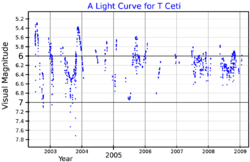Astronomy:T Ceti
| Observation data Equinox J2000.0]] (ICRS) | |
|---|---|
| Constellation | Cetus |
| Right ascension | 00h 21m 46.27529s[2] |
| Declination | −20° 03′ 28.9098″[2] |
| Apparent magnitude (V) | 5.61[3] (5.0 - 6.9)[4] |
| Characteristics | |
| Spectral type | M5.5e − M8.8e[5] |
| B−V color index | 1.58±0.03[3] |
| Variable type | SRc[6] |
| Astrometry | |
| Radial velocity (Rv) | +28.9±0.9[7] km/s |
| Proper motion (μ) | RA: +59.665[2] mas/yr Dec.: −10.229[2] mas/yr |
| Parallax (π) | 3.70 ± 0.47[8] mas |
| Distance | approx. 900 ly (approx. 270 pc) |
| Absolute magnitude (MV) | −1.51[3] |
| Details[6] | |
| Mass | 3.0±0.3 M☉ |
| Radius | 275±34 R☉ |
| Luminosity | 8,128+2,587 −1,962 L☉ |
| Surface gravity (log g) | 0.01±0.11 cgs |
| Temperature | 3,396+103 −100 K |
| Metallicity [Fe/H] | 0.0 dex |
| Other designations | |
| Database references | |
| SIMBAD | data |
T Ceti is a semiregular variable star located in the equatorial constellation of Cetus. It varies between magnitudes 5.0 and 6.9 over 159.3 days.[4] The stellar parallax shift measured by Hipparcos is 3.7 mas,[8] which yields a distance estimate of roughly 900 light years. It is moving further from the Earth with a heliocentric radial velocity of +29 km/s.[7]
This is an MS-type star on the asymptotic giant branch with a spectral type of M5-6Se.[10] It is often classified simply as an M-type star, for example with the spectral type of M5.5e − M8.8e.[11] (The 'e' notation indicates the presence of emission lines in the spectrum.) It is a long period Mira variable with changing cycle lengths, showing a variation in its spectral features over the course of each cycle. Pulsation periods of 388, 398, and 382 days have been reported, as well as variations in the amplitude, which may indicate dual pulsation cycles that are interfering with each other.[5] The star is losing mass at the rate of 8.2×10−8 M☉ y−1,[12] and it is surrounded by a circumstellar dust shell consisting of crystallized, mostly iron-rich silicates.[5]
T Ceti has an estimated three times the mass of the Sun and has expanded to 275 times the Sun's radius. It is radiating 8,128 times the Sun's luminosity from its enlarged photosphere at an effective temperature of 3,396 K.[6]
References
- ↑ "ASAS All Star Catalogue". The All Sky Automated Survey. http://www.astrouw.edu.pl/asas/?page=aasc.
- ↑ 2.0 2.1 2.2 2.3 Brown, A. G. A. (August 2018). "Gaia Data Release 2: Summary of the contents and survey properties". Astronomy & Astrophysics 616: A1. doi:10.1051/0004-6361/201833051. Bibcode: 2018A&A...616A...1G.
- ↑ 3.0 3.1 3.2 Anderson, E.; Francis, Ch. (2012). "XHIP: An extended hipparcos compilation". Astronomy Letters 38 (5): 331. doi:10.1134/S1063773712050015. Bibcode: 2012AstL...38..331A.
- ↑ 4.0 4.1 Samus', N. N; Kazarovets, E. V; Durlevich, O. V; Kireeva, N. N; Pastukhova, E. N (2017). "General catalogue of variable stars: Version GCVS 5.1". Astronomy Reports 61 (1): 80. doi:10.1134/S1063772917010085. Bibcode: 2017ARep...61...80S.
- ↑ 5.0 5.1 5.2 Guha Niyogi, Suklima et al. (June 2011), "A Temporal Study of the Oxygen-rich Pulsating Variable Asymptotic Giant Branch Star, T Cep: Investigation on Dust Formation and Dust Properties", The Astrophysical Journal 733 (2): 15, doi:10.1088/0004-637X/733/2/93, 93, Bibcode: 2011ApJ...733...93G
- ↑ 6.0 6.1 6.2 Cruzalebes, P. et al. (2013). "Fundamental parameters of 16 late-type stars derived from their angular diameter measured with VLTI/AMBER". Monthly Notices of the Royal Astronomical Society 434 (1): 437–450. doi:10.1093/mnras/stt1037. Bibcode: 2013MNRAS.434..437C.
- ↑ 7.0 7.1 de Bruijne, J. H. J.; Eilers, A.-C. (October 2012), "Radial velocities for the HIPPARCOS-Gaia Hundred-Thousand-Proper-Motion project", Astronomy & Astrophysics 546: 14, doi:10.1051/0004-6361/201219219, A61, Bibcode: 2012A&A...546A..61D.
- ↑ 8.0 8.1 van Leeuwen, F. (2007). "Validation of the new Hipparcos reduction". Astronomy and Astrophysics 474 (2): 653–664. doi:10.1051/0004-6361:20078357. Bibcode: 2007A&A...474..653V.
- ↑ "T Cet". SIMBAD. Centre de données astronomiques de Strasbourg. http://simbad.u-strasbg.fr/simbad/sim-basic?Ident=T+Cet.
- ↑ Keenan, Philip C (1954). "Classification of the S-Type Stars". The Astrophysical Journal 120: 484. doi:10.1086/145937. Bibcode: 1954ApJ...120..484K.
- ↑ Onaka, T; De Jong, T; Yamamura, Issei; Cami, J; Tanab'e, T (1999). "Time variation observations of ISO SWS spectra of two oxygen-rich Mira variables". The Universe as Seen by Iso 427: 381. Bibcode: 1999ESASP.427..381O.
- ↑ Wallerstein, G. et al. (November 2011), "Carbon isotopic abundance ratios in S-type stars", Astronomy & Astrophysics 535: 7, doi:10.1051/0004-6361/201015280, A101, Bibcode: 2011A&A...535A.101W
 |


